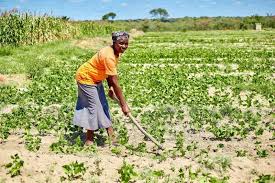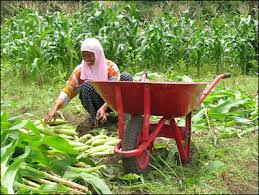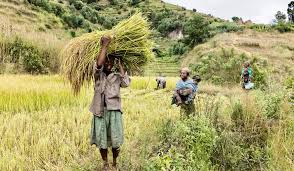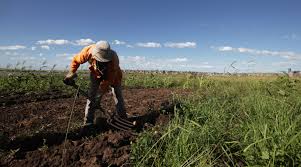The role of agriculture in economic development is crucial because the majority of the population in developing countries make their living from agriculture. Agriculture plays the following role in the economic development of developing countries:
i. Contribution to National Income.
ii. Source of Food Supply.
iii. Provision of Surplus.
iv. Shift of Manpower from Agriculture to Non-agricultural Sector.
v. Creation of Infrastructure.
vi. Relief from Shortage of Capital.
vii. Helpful to Reduce Inequality.
viii. Helpful in Minimizing Political and Social Tensions.
ix. Helpful in Stimulating the Growth of the Non-agricultural Sector.
x. Helpful in Phasing out Economic Depression.
xi. Source of Foreign Exchange for the Country.
xii. Contribution to Capital Formation.
xiii. Employment Opportunities for Rural People.
xiv. Improving the Welfare of Rural Dwellers.
xv. Extension of Market for Industrial Output.
1. Contribution to National Income
The lessons drawn from the economic history of many advanced countries tell us that agricultural prosperity contributed considerably to fostering economic advancement.
It is correctly observed that “The leading industrialized countries of today were once predominantly agricultural, while the developing economies still have the dominance of agriculture and it largely contributes to the national income.”
2. Source of Food Supply
Agriculture is the basic source of the food supply of all the countries of the world whether underdeveloped, developing, or even developed. Due to the heavy pressure of population in underdeveloped and developing countries and its rapid increase, the demand for food is increasing at a fast rate.
If agriculture fails to meet the rising demand for food products, it adversely affects the growth rate of the economy. Raising the supply of food by the agricultural sector, therefore, has great importance for the economic growth of a country.
The increase in demand for food in an economy is determined by the following equation:
D = P + 2g, Where:
D stands for Annual Rate of Growth in demand for food.
P stands for Population Growth Rate.
g stands for Rate of Increase in Per Capita Income.
2 stands for Income Elasticity of Demand for Agricultural Products.
Agricultural advancement is necessary for improving the supply of raw materials for agro-allied industries, especially in developing countries. The shortage of agricultural goods has its impact on industrial production and a consequent increase in the general price level.
It will impede the growth of the country’s economy. The flour mills, rice shellers, oil mills, bread, meat, milk products, sugar factories, wineries, jute mills, textile mills, and numerous other industries are based on agricultural products.
Read Also: The Major Causes of Cannibalism among Poultry Birds
3. Provision of Surplus

The progress in the agricultural sector provides a surplus for increasing the exports of agricultural products. In the earlier stages of development, an increase in export earnings is more desirable because of the greater strains on the foreign exchange situation needed for the financing of imports of basic and essential capital goods.
Johnson and Mellor are of the opinion, “Given the urgent need for enlarged foreign exchange earnings and the lack of alternative opportunities, a substantial expansion of agricultural export production is frequently a rational policy even though the world supply-demand situation for a commodity is unfavorable.”
4. The Shift of Manpower from Agriculture to Non-agricultural Sector
Initially, agriculture absorbs a large quantity of the labor force. In Nigeria, still about 70% of labor is absorbed in this sector. Agricultural progress permits the shift of manpower from agriculture to the non-agricultural sector.
In the initial stages, the diversion of labor from agriculture to the non-agricultural sector is more important for economic development as it eases the burden of the surplus labor force over the limited land. Thus, the release of surplus manpower from the agricultural sector is necessary for the progress of the agricultural sector and for expanding the non-agricultural sector.
The development of agriculture in modern times would bring about a decline in the percentage of the labor force engaged in agriculture and release some to industry.
5. Creation of Infrastructure
The development of agriculture requires roads, markets, storage facilities, transportation, railways, postal services, and many others, which create demand for industrial products and contribute to the development of the commercial sector.
6. Relief from Shortage of Capital
The development of the agricultural sector has minimized the burden of several developed countries that were facing a shortage of foreign capital. If foreign capital is available with the ‘strings’ attached to it, it will create another significant problem. The agricultural sector requires less capital for its development. Thus, it minimizes the growth problem of foreign capital.
7. Helpful to Reduce Inequality
In a country which is predominantly agricultural and overpopulated, there is greater inequality of income between the rural and urban areas of the country. To reduce this inequality of income, it is necessary to accord higher priority to agriculture. The prosperity of agriculture would raise the income of the majority of the rural population, and thus the disparity in income may be reduced to a certain extent.
8. Helpful in Minimizing Political and Social Tensions

If the agricultural sector does not grow at a faster rate, it may result in growing discontentment among the masses, which is never healthy for the smooth running of democratic governments.
For economic development, it is necessary to minimize political as well as social tensions. If the majority of the people have to be kindled with the hopes of prosperity, this can be attained with the help of agricultural progress. Thus, the development of the agriculture sector is also relevant on political and social grounds.
9. Helpful in Stimulating the Growth of the Non-agricultural Sector
The development of the agricultural sector would tend to increase the purchasing power of agriculturists, which will help the growth of the non-agricultural sector of the country. It will provide a market for increased production.
In underdeveloped countries, it is well known that the majority of people depend upon agriculture, and it is they who must be able to afford to consume the goods produced. Therefore, it will be helpful in stimulating the growth of the non-agricultural sector.
Similarly, improvement in the productivity of cash crops may pave the way for the promotion of an exchange economy, which may help the growth of the non-agricultural sector. The purchase of industrial products such as pesticides, farm machinery, etc., also provides a boost to the industrial output.
10. Helpful in Phasing out Economic Depression
During the economic depression, industrial production can be stopped or reduced, but agricultural production continues as it produces necessities of life. Thus, it continues to create effective demand even during adverse conditions of the economy.
11. Source of Foreign Exchange for the Country
Most of the developing countries of the world are exporters of primary products. These products contribute 60 to 70 percent of their total export earnings. Thus, the capacity to import capital goods and machinery for industrial development depends crucially on the export earnings of the agriculture sector.
If exports of agricultural goods fail to increase at a sufficiently high rate, these countries are forced to incur a heavy deficit in the balance of payments, resulting in a serious foreign exchange problem. However, primary goods face declining prices in the international market, and the prospects of increasing export earnings through them are limited.
Due to this, large developing countries like India (having potentialities of industrial development) are trying to diversify their production structure and promote the exports of manufactured goods even though this requires the adoption of protective measures in the initial period of planning.
12. Contribution to Capital Formation
Underdeveloped and developing countries need a huge amount of capital for their economic development. In the initial stages of economic development, it is agriculture that constitutes a significant source of capital formation.
13. Employment Opportunities for Rural People
Agriculture provides employment opportunities for rural people on a large scale in underdeveloped and developing countries. It is an important source of livelihood.
Generally, landless workers and marginal farmers are engaged in non-agricultural jobs like handicrafts, furniture, textiles, leather, metalwork, processing industries, and other service sectors. These rural units fulfill merely local demands. In Nigeria and even India, about 70% of the total labor force depends upon agriculture.
Read Also: 15 MANAGEMENT TIPS FOR BETTER POULTRY PERFORMANCE
14. Improving the Welfare of Rural Dwellers

It is time that rural economies depend on agriculture and allied occupations in underdeveloped countries. The rising agricultural surplus caused by increasing agricultural production and productivity tends to improve welfare, particularly in rural areas.
The living standard of rural masses rises, and they start consuming a nutritious diet, including eggs, milk, and fruits. They lead a comfortable life having all modern amenities a better house, motorcycle, radio, television, and use of better clothes.
15. Extension of Market for Industrial Output
As a result of agricultural progress, there will be an extension of the market for industrial products. An increase in agricultural productivity leads to an increase in the income of the rural population, which in turn leads to more demand for industrial products, thus aiding the development of the industrial sector.
According to Dr. Bright Singh, “Increase in agricultural production and the rise in the per-capita income of the rural community, together with industrialization and urbanization, lead to increased demand for industrial production.” In this way, the agricultural sector helps promote economic growth by securing a supplement to the industrial sector.
Simon Kuznets identifies four possible types of contribution that the agricultural sector is capable of making for overall economic development, namely:
1. Product Contribution: Making available food and raw materials.
2. Market Contribution: Providing the market for producer goods and consumer goods produced in the non-agricultural sector.
3. Factor Contribution: Making available labor and capital to the non-agricultural sector.
4. Foreign Exchange Contribution.
In this article, the role of agriculture in economic development has been discussed, which includes the generation of national income, food supply, provision of surplus, employment, and more. The roles as classified by Simon Kuznets have also been highlighted.
Do you have any questions, suggestions, or contributions? If so, please feel free to use the comment box below to share your thoughts. We also encourage you to kindly share this information with others who might benefit from it. Since we can’t reach everyone at once, we truly appreciate your help in spreading the word. Thank you so much for your support and for sharing!

